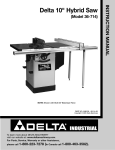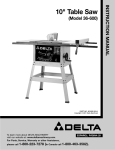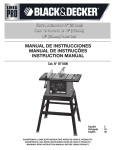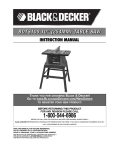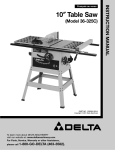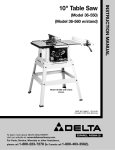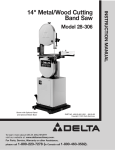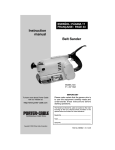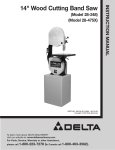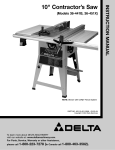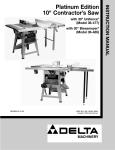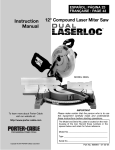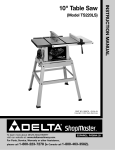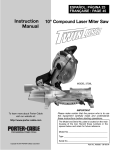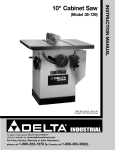Download Porter-Cable 38129 Saw User Manual
Transcript
ESPAÑOL: PÁGINA 23 FRANÇAISE : PAGE 43 Instruction Manual Double Insulated 10" Bench Top Table Saw MODEL 3812 Shown assembled with accessory stand model 38129 and accessory outfeed support model 38239. To learn more about Porter-Cable visit our website at: http://www.porter-cable.com IMPORTANT Please make certain that the person who is to use this equipment carefully reads and understands these instructions before starting operations. The Model and Serial No. plate is located on the main housing of the tool. Record these numbers in the spaces below and retain for future reference. Model No. _____________________________________ Type __________________________________________ Serial No.______________________________________ Copyright © 2003 PORTER-CABLE Corporation Part No. 912933 - 09-15-03 SAFETY GUIDELINES - DEFINITIONS This manual contains information that is important for you to know and understand. This information relates to protecting YOUR SAFETY and PREVENTING EQUIPMENT PROBLEMS. To help you recognize this information, we use the symbols to the right. Please read the manual and pay attention to these sections. Indicates an imminently hazardous situation which, if not avoided, will result in death or serious injury. Indicates a potentially hazardous situation which, if not avoided, could result in death or serious injury. Indicates a potentially hazardous situation which, if not avoided, may result in minor or moderate injury. Used without the safety alert symbol indicates potentially hazardous situation which, if not avoided, may result in property damage. SOME DUST CREATED BY POWER SANDING, SAWING, GRINDING, DRILLING, AND OTHER CONSTRUCTION ACTIVITIES contains chemicals known to cause cancer, birth defects or other reproductive harm. Some examples of these chemicals are: · lead from lead-based paints, · crystalline silica from bricks and cement and other masonry products, and · arsenic and chromium from chemically-treated lumber. Your risk from these exposures varies, depending on how often you do this type of work. To reduce your exposure to these chemicals: work in a well ventilated area, and work with approved safety equipment, always wear MSHA/NIOSH approved, properly fitting face mask or respirator when using such tools. GENERAL SAFETY RULES READ AND UNDERSTAND ALL WARNINGS AND OPERATING INSTRUCTIONS BEFORE USING THIS EQUIPMENT. Failure to follow all instructions listed below, may result in electric shock, fire, and/or serious personal injury or property damage. IMPORTANT SAFETY INSTRUCTIONS Woodworking can be dangerous if safe and proper operating procedures are not followed. As with all machinery, there are certain hazards involved with the operation of the product. Using the machine with respect and caution will considerably lessen the possibility of personal injury. However, if normal safety precautions are overlooked or ignored, personal injury to the operator may result. Safety equipment such as guards, push sticks, hold-downs, featherboards, goggles, dust masks and hearing protection can reduce your potential for injury. But even the best guard won’t make up for poor judgment, carelessness or inattention. Always use common sense and exercise caution in the workshop. If a procedure feels dangerous, don’t try it. Figure out an alternative procedure that feels safer. REMEMBER: Your personal safety is your responsibility. For additional information please visit our website www.portercable.com. This machine was designed for certain applications only. Porter-Cable strongly recommends that this machine not be modified and/or used for any application other than that for which it was designed. If you have any questions relative to a particular application, DO NOT use the machine until you have first contacted Porter-cable to determine if it can or should be performed on the product. Technical Service Manager Porter-Cable 4825 Highway 45 North Jackson, TN 38305 (IN CANADA: 505 SOUTHGATE DRIVE, GUELPH, ONTARIO N1H 6M7) 2 FAILURE TO FOLLOW THESE RULES MAY RESULT IN SERIOUS INJURY. 1. 2. 3. 4. 5. 6. 7. 8. 9. 10. 11. 12. 13. FOR YOUR OWN SAFETY, READ THE INSTRUCTION MANUAL BEFORE OPERATING THE MACHINE. Learning the machine’s application, limitations, and specific hazards will greatly minimize the possibility of accidents and injury. USE CERTIFIED SAFETY EQUIPMENT. Eye protection equipment should comply with ANSI Z87.1 standards, hearing equipment should comply with ANSI S3.19 standards, and dust mask protection should comply with MSHA/NIOSH certified respirator standards. Splinters, air-borne debris, and dust can cause irritation, injury, and/or illness. DRESS PROPERLY. Do not wear tie, gloves, or loose clothing. Remove watch, rings, and other jewelry. Roll up your sleeves. Clothing or jewelry caught in moving parts can cause injury. DO NOT USE THE MACHINE IN A DANGEROUS ENVIRONMENT. The use of power tools in damp or wet locations or in rain can cause shock or electrocution. Keep your work area well-lit to prevent tripping or placing arms, hands, and fingers in danger. MAINTAIN ALL TOOLS AND MACHINES IN PEAK CONDITION. Keep tools sharp and clean for best and safest performance. Follow instructions for lubricating and changing accessories. Poorly maintained tools and machines can further damage the tool or machine and/or cause injury. CHECK FOR DAMAGED PARTS. Before using the machine, check for any damaged parts. Check for alignment of moving parts, binding of moving parts, breakage of parts, and any other conditions that may affect its operation. A guard or any other part that is damaged should be properly repaired or replaced. Damaged parts can cause further damage to the machine and/or injury. KEEP THE WORK AREA CLEAN. Cluttered areas and benches invite accidents. KEEP CHILDREN AND VISITORS AWAY. Your shop is a potentially dangerous environment. Children and visitors can be injured. REDUCE THE RISK OF UNINTENTIONAL STARTING. Make sure that the switch is in the “OFF” position before plugging in the power cord. In the event of a power failure, move the switch to the “OFF” position. An accidental start-up can cause injury. USE THE GUARDS. Check to see that all guards are in place, secured, and working correctly to prevent injury. REMOVE ADJUSTING KEYS AND WRENCHES BEFORE STARTING THE MACHINE. Tools, scrap pieces, and other debris can be thrown at high speed, causing injury. USE THE RIGHT MACHINE. Don’t force a machine or an attachment to do a job for which it was not designed. Damage to the machine and/or injury may result. 14. 15. 16. 17. 18. 19. 20. 21. 22. 23. 24. 3 USE RECOMMENDED ACCESSORIES. The use of accessories and attachments not recommended by Porter-Cable may cause damage to the machine or injury to the user. USE THE PROPER EXTENSION CORD. Make sure your extension cord is in good condition. When using an extension cord, be sure to use one heavy enough to carry the current your product will draw. An undersized cord will cause a drop in line voltage, resulting in loss of power and overheating. See the Extension Cord Chart for the correct size depending on the cord length and nameplate ampere rating. If in doubt, use the next heavier gauge. The smaller the gauge number, the heavier the cord. SECURE THE WORKPIECE. Use clamps or a vise to hold the workpiece when practical. Loss of control of a workpiece can cause injury. FEED THE WORKPIECE AGAINST THE DIRECTION OF THE ROTATION OF THE BLADE, CUTTER, OR ABRASIVE SURFACE. Feeding it from the other direction will cause the workpiece to be thrown out at high speed. DON’T FORCE THE WORKPIECE ON THE MACHINE. Damage to the machine and/or injury may result. DON’T OVERREACH. Loss of balance can make you fall into a working machine, causing injury. NEVER STAND ON THE MACHINE. Injury could occur if the tool tips, or if you accidentally contact the cutting tool. NEVER LEAVE THE MACHINE RUNNING UNATTENDED. TURN THE POWER OFF. Don’t leave the machine until it comes to a complete stop. A child or visitor could be injured. TURN THE MACHINE “OFF”, AND DISCONNECT THE MACHINE FROM THE POWER SOURCE before installing or removing accessories, before adjusting or changing set-ups, or when making repairs. An accidental start-up can cause injury. MAKE YOUR WORKSHOP CHILDPROOF WITH PADLOCKS, MASTER SWITCHES, OR BY REMOVING STARTER KEYS. The accidental start-up of a machine by a child or visitor could cause injury. STAY ALERT, WATCH WHAT YOU ARE DOING, AND USE COMMON SENSE. DO NOT USE THE MACHINE WHEN YOU ARE TIRED OR UNDER THE INFLUENCE OF DRUGS, ALCOHOL, OR MEDICATION. A moment of inattention while operating power tools may result in injury. THE DUST GENERATED by certain woods and wood products can be injurious to your health. Always operate machinery in well-ventilated areas, and provide for proper dust removal. Use wood dust collection systems whenever possible. ADDITIONAL SAFETY RULES FOR TABLE SAWS FAILURE TO FOLLOW THESE RULES MAY RESULT IN SERIOUS INJURY. 1. DO NOT OPERATE THIS MACHINE until it is assembled and installed according to the instructions. 10. NEVER perform “free-hand” operations. Use either the fence or miter gauge to position and guide the workpiece. 2. OBTAIN ADVICE FROM YOUR SUPERVISOR, instructor, or another qualified person if you are not familiar with the operation of this machine. 11. HOLD THE WORKPIECE FIRMLY against the miter gauge or fence. 12. USE PUSH STICK(S) for ripping a narrow workpiece. 3. FOLLOW ALL WIRING CODES and recommended electrical connections. 4. USE THE GUARDS WHENEVER POSSIBLE. Check to see that they are in place, secured, and working correctly. 5. AVOID KICKBACK by: A. keeping blade sharp and free of rust and pitch. B. keeping rip fence parallel to the saw blade. C. using saw blade guard and spreader for every possible operation, including all through sawing. D. pushing the workpiece past the saw blade prior to release. E. never ripping a workpiece that is twisted or warped, or does not have a straight edge to guide along the fence. F. using featherboards when the anti-kickback device cannot be used. G. never sawing a large workpiece that cannot be controlled. H. never using the fence as a guide when crosscutting. I. never sawing a workpiece with loose knots or other flaws. 6. ALWAYS USE GUARDS, SPLITTER, AND ANTIKICKBACK FINGERS whenever possible. 13. AVOID AWKWARD OPERATIONS AND HAND POSITIONS where a sudden slip could cause a hand to move into the blade. 14. KEEP ARMS, HANDS, AND FINGERS away from the blade. 15. NEVER have any part of your body in line with the path of the saw blade. 16. NEVER REACH AROUND or over the saw blade. 17. NEVER attempt to free a stalled saw blade without first turning the machine “OFF”. 18. PROPERLY SUPPORT LONG OR WIDE workpieces. 19. NEVER PERFORM LAYOUT, assembly or set-up work on the table/work area when the machine is running. 20. TURN THE MACHINE “OFF” AND DISCONNECT THE MACHINE from the power source before installing or removing accessories, before adjusting or changing set-ups, or when making repairs. 21. TURN THE MACHINE “OFF”, disconnect the machine from the power source, and clean the table/work area before leaving the machine. LOCK THE SWITCH IN THE “OFF” POSITION to prevent unauthorized use. 22. ADDITIONAL INFORMATION regarding the safe and proper operation of power tools (i.e. a safety video) is available from the Power Tool Institute, 1300 Sumner Avenue, Cleveland, OH 44115-2851 (www.powertoolinstitute.com). Information is also available from the National Safety Council, 1121 Spring Lake Drive, Itasca, IL 60143-3201. Please refer to the American National Standards Institute ANSI 01.1 Safety Requirements for Woodworking Machines and the U.S. Department of Labor OSHA 1910.213 Regulations. 7. REMOVE CUT-OFF PIECES AND SCRAPS from the table before starting the saw. The vibration of the machine may cause them to move into the saw blade and be thrown out. After cutting, turn the machine off. After the blade has come to a complete stop, remove all debris. 8. NEVER START THE MACHINE with the workpiece against the blade. 9. NEVER run the workpiece between the fence and a moulding cutterhead. SAVE THESE INSTRUCTIONS. Refer to them often and use them to instruct others. 4 POWER CONNECTIONS A separate electrical circuit should be used for your machines. This circuit should not be less than #12 wire and should be protected with a 20 Amp time lag fuse. If an extension cord is used, use only 3-wire extension cords which have 3prong grounding type plugs and matching receptacle which will accept the machine’s plug. Before connecting the machine to the power line, make sure the switch (s) is in the “OFF” position and be sure that the electric current is of the same characteristics as indicated on the machine. All line connections should make good contact. Running on low voltage will damage the machine. DO NOT EXPOSE THE MACHINE TO RAIN OR OPERATE THE MACHINE IN DAMP LOCATIONS. POLARIZED PLUGS: To reduce the risk of electric shock, this equipment has a polarized plug (one blade is wider than the other). This plug will fit in a polarized outlet only one way. If the plug does not fit fully in the outlet, reverse the plug. If it still does not fit, contact a qualified electrician to install the proper outlet. Do not change the plug in any way. MOTOR Many Porter-Cable tools will operate on either D.C., or single phase 25 to 60 cycle A.C. current and voltage within plus or minus 5 percent of that shown on the specification plate of the tool. Several models, however, are designed for A.C. current only. Refer to the specification plate on your tool for proper voltage and current rating. Do not operate your tool on a current where the voltage is not within correct limits. Do not operate tools rated A.C. on a D.C. current. To do so may seriously damage the tool. REPLACEMENT PARTS When servicing, use only identical replacement parts. EXTENSION CORDS Use proper extension cords. Make sure your extension cord is in good condition. When using an extension cord, be sure to use one heavy enough to carry the current of the machine. An undersized cord will cause a drop in line voltage, resulting in loss of power and overheating. Fig. D, shows the correct gauge to use depending on the cord length. If in doubt, use the next heavier gauge. The smaller the gauge number, the heavier the cord. MINIMUM GAUGE EXTENSION CORD RECOMMENDED SIZES FOR USE WITH STATIONARY ELECTRIC MACHINES Ampere Rating 0-6 0-6 0-6 0-6 6-10 6-10 6-10 6-10 10-12 10-12 10-12 10-12 12-16 12-16 12-16 Volts 120 120 120 120 120 120 120 120 120 120 120 120 120 120 120 Total Length Gauge of of Cord in Feet Extension Cord up to 25 18 AWG 25-50 16 AWG 50-100 16 AWG 100-150 14 AWG up to 25 18 AWG 25-50 16 AWG 50-100 14 AWG 100-150 12 AWG up to 25 16 AWG 25-50 16 AWG 50-100 14 AWG 100-150 12 AWG up to 25 14 AWG 25-50 12 AWG GREATER THAN 50 FEET NOT RECOMMENDED Fig. D FUNCTIONAL DESCRIPTION FOREWORD The Porter-Cable Model 3812 is a 10" Bench Top Table Saw. The saw comes with a 26"x20" table surface with a rip fence extension wing which provides a 24½" rip capacity for ripping 4x8 sheets. The Model 3812 comes with a Riptide™ 24 tooth carbide-tipped blade, miter gauge, rip fence, quick release blade guard, and blade changing wrenches. UNPACKING AND CLEANING Carefully unpack the machine and all loose items from the shipping container. Remove the protective coating from all unpainted surfaces. This coating may be removed with a soft cloth moistened with kerosene (do not use acetone, gasoline or lacquer thinner for this purpose). After cleaning, cover the unpainted surfaces with a good quality household floor paste wax. NOTICE: THE MANUAL COVER PHOTO ILLUSTRATES THE CURRENT PRODUCTION MODEL. ALL OTHER ILLUSTRATIONS ARE REPRESENTATIVE ONLY AND MAY NOT DEPICT THE ACTUAL COLOR, LABELING OR ACCESSORIES AND MAY BE INTENDED TO ILLUSTRATE TECHNIQUE ONLY. 5 CARTON CONTENTS 1 2 4 3 5 6 Fig. 2 1. Saw 2. Fence 3. Table Insert 4. Blade Guard and Spreader Assembly 5. Blade Wrench (2) 6. Miter Gauge 7. Anchor Block Shim (3) 8. Handle 9. 1/4"-20x1-3/4" Screw 6 7 8 9 ASSEMBLY FOR YOUR OWN SAFETY, DO NOT CONNECT THE MACHINE TO THE POWER SOURCE UNTIL THE MACHINE IS COMPLETELY ASSEMBLED AND YOU READ AND UNDERSTAND THE ENTIRE INSTRUCTION MANUAL. BLADE RAISING AND LOWERING HANDWHEEL E D Insert the 1-3/4" screw (D) Fig. 4, through handle (E). Assemble handle (E) to handwheel (A) by threading screw (D) clockwise into handwheel as shown in Fig. 5. Handle (E) should rotate freely on screw (D). Fig. 4 E D A Fig. 5 BLADE GUARD AND SPREADER ASSEMBLY 1. DISCONNECT MACHINE FROM POWER SOURCE. A 2. THE BLADE GUARD AND SPREADER ASSEMBLY MUST BE PROPERLY ALIGNED TO THE SAW BLADE IN ORDER TO HELP PREVENT KICKBACK. B 3. Position the blade 90 degrees to the table and lock in place. Fig. 6 4. Insert spreader end (A) Fig. 6, of blade guard into anchor block (B). Push spreader (A) down into holder until you hear a click, indicating that the spreader is secured. NOTE: It is important that the spreader (A) be in the vertical position and pushed straight down into the spreader anchor block (B) during the assembly procedure. 5. Fig. 7 illustrates the blade guard in place. Fig. 7 7 6. NOTE: The anchor block (B) Fig. 6, has been adjusted at the factory so that the spreader will be aligned with the saw blade which is supplied with the saw. When changing to blades with different widths it may be necessary to adjust the anchor block (B) Fig. 9, as follows: 7. Remove table insert and saw blade. 8. Loosen the two screws (C) Fig. 8 (under saw table), that attach the anchor block (B) Fig. 9, to the saw frame (E). 9. Three additional shims, two of which are shown at (D) Fig. 9, are supplied with your saw and can be used as required between the anchor block (B) and the frame (E) in order to align the spreader with the saw blade. 10. After adjustment is completed, tighten the two screws (C) Fig. 8. C Fig. 8 B D REMOVING BLADE GUARD/SPREADER ASSEMBLY E DISCONNECT TOOL FROM POWER SOURCE. The blade must be in the 90 degree position to the table for the blade guard and spreader assembly to be removed. Remove the table insert, pull out on the spreader release spring (A) Fig. 9A, while pulling up on the blade guard/spreader assembly (B). NOTE: STORE THE BLADE GUARD AS SHOWN IN FIG. 31A, WHEN THE BLADE GUARD IS NOT IN USE. Fig. 9 B A MITER GAGE The miter gage is shipped completely assembled and is supplied with a T-slot miter gage bar (A) Fig. 10, that can be inserted into either one of the two T-slotted miter gage grooves located in the table top, as shown. The Tslot miter gage can be extended beyond the front of the table for cross-cutting wide workpieces. Fig. 9A MITER GAGE HOLDER Fig. 11, illustrates the miter gage (D) inserted into the miter gage holder when not in use. A D Fig. 10 Fig. 11 8 RIP FENCE TO SAW TABLE 1. The rip fence may be used on the right or left hand side of the saw table. Lift locking handle (A) Fig. 12, and position the front end of the fence on the front fence rail as shown. A 2. While pressing front end of fence firmly against front fence rail, place rear end of fence down on the rear fence rail and push down on locking handle (A) Fig. 13, to lock fence in place. Fig. 12 FASTENING SAW TO A SUPPORTING SURFACE A The saw MUST be properly secured to a supporting surface using the four mounting holes, two of which are shown at (A) Fig. 14. THE SUPPORTING SURFACE MUST BE ABLE TO SUPPORT 300LBS. Fig. 13 A HOLE MUST BE PROVIDED IN THE SUPPORTING SURFACE TO FACILITATE SAWDUST FALL-THRU AND REMOVAL. Square the saw on the supporting surface and mark the location of the four 5/16 inch holes to be drilled, as shown in Fig. 15. Locate and mark an 11 or 12 inch square centered between the four mounting holes and cut out and remove the square, as shown in Fig. 15. This opening will allow sawdust to fall through the saw base. Fasten the saw to the workbench utilizing the mounting holes that were just drilled. A Fig. 14 FAILURE TO PROVIDE THIS SAW DUST FALL-THRU AND REMOVAL HOLE WILL ALLOW SAW DUST TO BUILD-UP AROUND THE MOTOR WHICH MAY RESULT IN A FIRE HAZARD OR CAUSE MOTOR DAMAGE. SAW PLACEMENT MARKS FASTENING SAW TO TWO SAW HORSES 5/16" HOLES 11" OR 12" SQUARE CUTOUT When fastening the saw to two saw horses, position the four grooves located on the base of the saw cabinet over the 2x4’s of the saw horse and fasten in place with suitable hardware (not supplied). CAUTION: THE SAW HORSES MUST BE ABLE TO SUPPORT 300 LBS. Fig. 15 9 OPERATING CONTROLS AND ADJUSTMENTS STARTING AND STOPPING SAW The “ON/OFF” switch (A) Fig 16, is located on the front of the saw cabinet. To turn the saw “ON” pull the “ON/OFF” switch (A) out. To turn the saw “OFF”, push in on the “ON/OFF” switch (A). SOFT START A Model 3812 has a “Soft Start” feature designed to minimize startup reaction torque. LOCKING SWITCH IN THE “OFF” POSITION Fig. 16 IMPORTANT: When the tool is not in use the switch should be locked in the “OFF” position to prevent unauthorized use. The tool can be locked in the “OFF” position using a padlock (A) as shown in Fig. 17. The padlock should have 3/16" diameter shank with a 2" throat to insure a proper fit. BLADE RAISING AND LOWERING CONTROL To raise or lower the saw blade, turn handwheel (A) Fig 18. Turning the handwheel counterclockwise lowers the blade and turning the handwheel clockwise raises the blade. THE BLADE TILTING LOCK HANDLE (B) FIG. 19, MUST BE LOCKED DURING ALL CUTTING OPERATIONS. A Fig. 17 BLADE TILTING CONTROL To tilt the saw blade, loosen blade tilting lock handle (B) Fig. 19, rotate outer wheel (C) until the blade is at the desired angle and tighten lock handle (B). THE BLADE TILTING LOCK HANDLE (B) FIG. 19 MUST BE LOCKED DURING ALL CUTTING OPERATIONS. A ADJUSTING TABLE INSERT Place a straight edge (B) across the table at both ends of the table insert as shown in Fig. 19A. The table insert (A) should always be level with the table. If an adjustment is necessary, turn the adjusting screws (C), as needed. Four adjusting screws (C) are supplied. Fig. 18 B C C C A B Fig. 19A Fig. 19 10 ADJUSTING 0 AND 45 DEGREE POSITIVE STOPS A Your saw is equipped with positive stops for rapid and accurate positioning of the saw blade at 0 and 45 degrees to the table. This saw has the capability to go 2 degrees beyond 0 and 45 degrees (-2º to 47º). To adjust the positive stops, proceed as follows: 1. DISCONNECT MACHINE FROM POWER SOURCE. 2. Remove the blade guard and spreader assembly. NOTE: SEE THE SECTION “REMOVING BLADE GUARD/SPREADER ASSEMBLY.” 3. Raise the saw blade to its maximum height. B Fig. 20 TO ADJUST POSITIVE STOP AT 0 DEGREES 4. Loosen the blade tilting lock handle, move the blade tilting mechanism as far as possible to the left and tighten the blade tilting lock handle. 5. Place a square (A) Fig. 20, on the table with one end of the square against the blade, as shown, and check to see if the blade is at 90 degrees to the table. If it is not, loosen screw (B) a few turns and move the blade tilting mechanism until the blade measures 90 degrees to the table. Then tighten blade tilting lock handle and tighten screw (B) until it bottoms. NOTE: CHECK TO SEE IF THE TILT INDICATOR POINTER POINTS TO THE ZERO MARK ON THE SCALE. ADJUST IF NECESSARY. A C Fig. 21 TO ADJUST POSITIVE STOP AT 45 DEGREES 6. Loosen the blade tilting lock handle, move the blade tilting mechanism as far as possible to the right and tighten the blade tilting lock handle. 7. Place a square (A) Fig. 21, on the table with one end of the square against the blade as shown, and check to see if the blade is at 45 degrees to the table. If it is not, loosen screw (C) a few turns and move the blade tilting mechanism until the blade is at 45 degrees to the table. Then tighten blade tilting lock handle and tighten screw (C) until it bottoms. A B F RIP FENCE OPERATION AND ADJUSTMENTS D D 1. To move the rip fence (A) Fig. 22A, along the table, lift up fence locking lever (B), slide the fence to the desired location on the table and push down fence locking lever (B) to lock the fence in position. 2. A pointer is supplied to indicate the distance the fence is positioned away from the saw blade. If an adjustment to the pointer (D) is required, loosen the screws (C) Fig. 22B, that fasten the pointer window to the fence head and adjust the pointer accordingly. NOTE: THE RIP SCALE HAS TWO SETS OF MEASUREMENTS DISPLAYED ON IT. THE TOP SCALE IS USED WHEN THE RIP FENCE GUIDE RAIL IS COLLAPSED. THE BOTTOM SCALE IS USED WHEN THE RIP FENCE GUIDE RAIL IS FULLY EXTENDED. Fig. 22A D C Fig. 22B 11 3. THE RIP FENCE MUST BE PARALLEL TO THE MITER GAGE SLOT AND SAW BLADE TO HELP PREVENT KICKBACK WHEN RIPPING. 4. The saw blade is set parallel to the miter gage slot at the factory and the fence must be parallel to the miter gage slot and saw blade in order to do accurate work and help prevent kickback when ripping. To check the alignment: 5. Position the fence close to the miter gage slot, as shown in Fig. 22A. Push fence toward saw to insure alignment screws are in contact with the fence rail. Clamp the fence to the table by pushing down the locking lever (B). The fence should be parallel with the miter gage slot. 6. If an adjustment is necessary, proceed as follows: 7. Loosen the two screws and jam nuts (D) Fig. 22A, and lift up locking lever (B). Then while holding the fence bracket (F) Fig. 22A firmly toward the rear, move the rear end of the fence (A), by adjusting the two screws (D) until the fence is parallel with the miter gage slot. Then push down locking lever (B). Tighten jam nuts (D) on adjusting screws. 8. The clamping action of the fence (A) Fig. 23, can be adjusted by lifting up locking lever (B) and turning nut (E) clockwise to increase or counterclockwise to decrease the tension of the clamping action of the fence. B H E G Fig. 23 REPLACING THE RIP FENCE SCALE A metric scale can be attached to the rip fence as follows: 1. Extend the rip fence guide rail as far as it will go. 2. Use a pencil and “mark” the guide rail at the “0” location of the scale and remove the standard scale. 3. Place the metric scale on the guide rail referencing the “0” mark. 4. Collapse the guide rail and check to see if the “0” mark is accurate. 5. If an adjustment is necessary, adjust the “0” mark by loosening nut (G) Fig. 23, and turning screw (H) clockwise to move the “0” mark to the left, and counter clockwise to move the “0” mark to the right, once the “0” is set properly on the rip fence guide rail, turn nut (G) counterclockwise to lock nut (G) against screw (H). A Fig. 24 RIP FENCE EXTENSION The saw has the capability to increase its ripping capacity by extending the rip fence guide rails. To extend the rip fence guide rails pull lever (A) Fig. 24, to the right, and pull out on the guide rails. Then lock the extended rails. C RIPPING THIN STOCK B To adjust the fence, pull up on lever (B) so that the top of the rip fence can be removed, and repositioned on the rip fence as shown in Fig. 25. This is only necessary when the fence guide rails are extended. When using the guide rails for ripping, the fence must be positioned as shown in Fig. 25, so that the wood can rest on the ledge (C,) up against the rip fence. An auxiliary wood insert can be placed in the gap between the saw table and the rip fence extension to add extra support. Fig. 25 12 MITER GAGE OPERATION AND ADJUSTMENTS When straight cross-cutting (blade set 90 degrees to the table) the miter gage can be used in either table slot. When bevel cross-cutting (blade tilted) only use the miter gage in the right table slot where the blade is tilted away from the miter gage and your hands. This miter gage is equipped with individually adjustable index stops at 90 degrees and 45 degrees right and left. Adjustment to the index stops can be made by loosening lock nuts (B) Fig. 26, and tightening or loosening the three adjusting screws (C) until they contact the other end of stop guard (D) when the miter gage is at 90 and 45 degrees to the saw blade. To operate the miter gage, simply loosen lock knob (E) Fig. 26, and move the body of the miter gage to the desired angle. E B C D Fig. 26 B A ADJUSTING BLADE PARALLEL TO MITER GAGE SLOTS Fig. 27 The blade was adjusted parallel to the miter gage slots at the factory. In order to insure accurate cuts and help prevent kickback when cutting, this adjustment should be periodically checked and if necessary, adjusted as follows: 1. DISCONNECT MACHINE FROM POWER SOURCE. 2. Raise the blade to its highest position and adjust the blade so it is 90 degrees to the table. Fig. 27A 3. Select a tooth on the saw blade that is set to the left. Mark this tooth with a pencil or marker. 4. Using a combination square, place the body (A) Fig. 27, of the square against the miter gage slot and adjust the blade (B) of the square until it just touches the marked tooth, as shown. A 5. Rotate the blade and check the same marked blade tooth at the rear of the saw table in the same manner, as shown in Fig. 27A. 6. If the front and back measurements, shown in Figs. 27 and 27A, are not identical, loosen the four trunnion bolts (A) Fig. 28, underneath the saw table. Carefully grasp and move the saw frame until the blade is parallel to the miter gage slot. Then tighten the four trunnion bolts securely. Fig. 28 B DUST PORT The saw has a dust port (B) Fig. 28A, located at the rear of the saw. The dust port is for connecting a dust collection system to the saw. The port is 2-1/2" outside diameter. Fig. 28A 13 OPERATIONS Common sawing operations include ripping and cross-cutting plus a few other standard operations of a fundamental nature. As with all power tools, there is a certain amount of hazard involved with the operation and use of the tool. Using the tool with the respect and caution demanded as far as safety precautions are concerned, will considerably lessen the possibility of personal injury. However, if normal safety precautions are overlooked or ignored, personal injury to the operator can result. The following information describes the safe and proper method for performing the most common sawing operations. CROSS-CUTTING Cross-cutting requires the use of the miter gage to position and guide the work. Place the work against the miter gage and advance both the gage and work toward the saw blade, as shown in Fig. 32. The miter gage may be used in either table slot. When bevel cutting (blade tilted), use the miter gage slot that does not cause interference of your hand or miter gage with the saw blade guard. The saw guard must always be used for all through cutting. Start the cut slowly and hold the work firmly against the miter gage and the table. One of the rules in running a saw is that you never hang onto or touch a free piece of work. Hold the supported piece, not the free piece that is cut off. The feed in cross-cutting continues until the work is cut in two, and the miter gage and work are pulled back to the starting point. Before pulling the work back it is good practice to give the work a little sideways shift to move the work slightly away from the saw blade. Never pick up any short length of free work from the table while the saw is running. WARNING: NEVER USE THE FENCE AS A CUTOFF GAGE WHEN CROSS-CUTTING. For added safety and convenience the miter gage can be fitted with an auxiliary wood-facing. This auxiliary wood-facing can be fastened to the front of the miter gage by using two wood screws through the slots provided in the miter gage body and into the woodfacing. RIPPING Ripping is the operation of making a length-wise cut through a board, as shown in Fig. 33, and the rip fence (A) is used to position and guide the work. One edge of the work rides against the rip fence while the flat side of the board rests on the table. Since the work is pushed along the fence, it must have a straight edge and make solid contact with the table. The saw guard must always be used. The guard has anti-kickback fingers to help prevent kickback and a spreader to help prevent the saw kerf from closing and binding the blade. Fig. 32 Start the motor and advance the work, holding it down against the fence. Never stand in the line of the saw cut when ripping. Hold the work with both hands and push it along the fence and into the saw blade as shown in Fig. 33. After the workpiece is on the table the work can then be fed through the saw blade with one hand, as shown in Fig. 34. After the work is beyond the saw blade and antikickback fingers the feed can continue to the end of the table, after which the work is lifted and brought back along the outside edge of the fence. The cut-off stock remains on the table or tilts up slightly and is caught by the rear end of the guard or slides off the table to the floor. If the cut-off stock remains on the table it is not touched with the hands until the saw blade is stopped, unless it is a large piece allowing safe removal. When ripping boards longer than three feet, it is recommended that a work support be used at the rear of the saw to keep the workpiece from falling off the saw table. Fig. 33 Fig. 34 14 If the ripped work is less than 4 inches wide, a PUSH STICK should always be used to complete the feed, as shown in Fig. 35. The PUSH STICK can easily be made from scrap material as explained in the section “CONSTRUCTING PUSH STICK.” When ripping stock 2 inches or narrower, assemble an auxiliary wood facing to the fence, as explained in the section “USING AUXILIARY WOOD FACING ON RIP FENCE” and use a PUSH STICK. USING AUXILIARY WOOD FACING ON RIP FENCE Fig. 35 It is necessary when performing some special operations to add wood facing (A) Fig. 36, to one or both sides of the rip fence, as shown. The wood facing is attached to the fence with wood screws through the holes in the fence. A A wood facing should be used when ripping material such as thin paneling to prevent the material from catching between the bottom of the rip fence and the saw table surface. Further information on the safe and proper operation of table saws is available in the Porter Cable/Delta “Getting the Most Out of Your Table Saw” How-To-Book, Catalog No. 11-400. Additional information on table saw safety is also available by writing to: Fig. 36 NATIONAL SAFETY COUNCIL 1121 Spring Lake Drive Itasca, IL 60143-3201 USING ACCESSORY DADO HEAD DO NOT USE A “WOBBLE” DADO BLADE, OR A DADO BLADE LARGER THAN 6" DIAMETER. IMPORTANT: THE BLADE GUARD AND SPREADER ASSEMBLY CANNOT BE USED WHEN DADOING, AND MUST BE REMOVED. Fig. 37 Dadoing is cutting a rabbet or wide groove into the work. Most dado head sets are made up of two outside saws and four or five inside cutters, as shown in Fig. 37. Various combinations of saws and cutters are used to cut grooves from 1/8" to 13/16" for use in shelving, making joints, tenoning, grooving, etc. The cutters are heavily swaged and must be arranged so that this heavy portion falls in the gullets of the outside saws, as shown in Fig. 38. The saw and cutter overlap is shown in Fig. 39, (A) being the outside saw, (B) an inside cutter, and (C) a paper washer or washers which can be used as needed to control the exact width of groove. A 1/4" groove is cut by using the two outside saws. The teeth of the saws should be positioned so that the raker on one saw is beside the cutting teeth on the other saw. Fig. 38 15 Fig. 39 Fig. 40 The dado head set (D) Fig. 40, is assembled to the saw arbor as shown. IMPORTANT: The blade guard and splitter assembly cannot be used when dadoing and must be removed. Auxiliary jigs, fixtures, push sticks and feather boards should also be used. Also, the accessory dado head table insert Delta model 38122 (E) Fig. 40, must be used in place of the standard table insert. Fig. 41, shows a typical dado operation using the miter gage as a guide. NEVER USE THE DADO HEAD IN A BEVEL POSITION. ALWAYS INSTALL BLADE GUARD AFTER OPERATION IS COMPLETED. Fig. 41 STORAGE For ease in storing and transporting, the saw can hold the following accessories as shown in Figs. 42 and 43. Fig. 42 A A - Wrenches B - Blade guard/Spreader assembly C - Fence D. - Extra Blade D B C Fig. 42 Fig. 43 E - Miter gage F - Cord F E Fig. 43 16 MAINTENANCE CHANGING THE BLADE 1. DISCONNECT MACHINE FROM POWER SOURCE. USE ONLY 10" DIAMETER SAW BLADES RATED FOR 4600 RPM OR HIGHER WITH 5/8" ARBOR HOLES. 2. Remove the table insert (A) Fig. 44, and raise the saw blade to its maximum height. A 3. Remove the blade guard and spreader assembly. NOTE: THE BLADE MUST BE IN THE 90 DEGREE POSITION TO THE TABLE FOR THE BLADE GUARD AND SPREADER ASSEMBLY TO BE REMOVED. Remove the table insert, pull out on the spreader release spring (A) Fig. 45, while pulling up on the blade guard/spreader assembly (B). Fig. 44 B 4. Using the open end wrench (B) Fig. 46, place open end of wrench on flats on inside blade flange to keep the saw arbor from rotating and remove arbor nut (C) with the closed end of wrench (D). Turn nut (C) counterclockwise to remove. Remove outside blade flange (E) and saw blade (F). A 5. Install new blade, making certain teeth of blade are pointing down at the front of the saw table and assemble the outside blade flange (E) Fig. 46, and arbor nut (C). Tighten nut (C) with wrench (D) by turning nut clockwise while holding arbor steady with other wrench (B). Fig. 45 D B 6. Replace the table insert, blade guard and spreader assembly, and store the two wrenches. E C F Fig. 46 KEEP TOOL CLEAN Periodically blow out all air passages with dry compressed air. Clean all plastic parts with a soft damp cloth. NEVER use solvents to clean plastic parts. They could possibly dissolve or otherwise damage the material. WEAR SAFETY GLASSES WHILE USING COMPRESSED AIR. FAILURE TO START Should your tool fail to start, check to make sure the prongs on the cord plug are making good contact with the outlet. Also, check for blown fuses or open circuit breakers in the line. BRUSH INSPECTION AND LUBRICATION For your continued safety and electrical protection, brush inspection and replacement on this tool should ONLY be performed by an AUTHORIZED PORTER-CABLE SERVICE STATION or a PORTER-CABLE SERVICE CENTER. At approximately 100 hours of use, take or send your tool to your nearest Authorized Porter-Cable Service Station to be thoroughly cleaned and inspected; worn parts replaced, when necessary, relubricated with fresh lubricant, if required; reassembled with new brushes; and performance tested. Any loss of power before the above maintenance check may indicate the need for immediate servicing of your tool. DO NOT CONTINUE TO OPERATE TOOL UNDER THIS CONDITION. If proper operating voltage is present, return your tool to the service station for immediate service. 17 SERVICE AND REPAIRS All quality tools will eventually require servicing or replacement of parts due to wear from normal use. These operations, including brush inspection and replacement, should ONLY be performed by either an AUTHORIZED PORTER-CABLE SERVICE STATION or a PORTER-CABLE•DELTA FACTORY SERVICE CENTER. All repairs made by these agencies are fully guaranteed against defective material and workmanship. We cannot guarantee repairs made or attempted by anyone other than these agencies. Should you have any questions about your tool, feel free to write us at any time. In any communications, please give all information shown on the nameplate of your tool (model number, type, serial number, etc.). ACCESSORIES A complete line of accessories is available from your Porter-Cable•Delta Supplier, Porter-Cable•Delta Factory Service Centers, and Porter-Cable Authorized Service Stations. Please visit our Web Site www.portercable.com for a catalog or for the name of your nearest supplier. Since accessories other than those offered by Porter-Cable•Delta have not been tested with this product, use of such accessories could be hazardous. For safest operation, only PorterCable•Delta recommended accessories should be used with this product. DO NOT USE A “WOBBLE” DADO BLADE, OR A DADO BLADE LARGER THAN 6" DIAMETER. CATALOG # 38121 38122 12910 12911 12912 38129 38239 DESCRIPTION Blade Insert Dado blade Insert 10" Blade 24 teeth 10" Blade 40 teeth 10" Blade 60 teeth Folding Stand Outfeed Support CONSTRUCTING A FEATHERBOARD Fig. 47, illustrates dimensions for making a typical featherboard. The material which the featherboard is constructed of, should be a straight piece of wood that is free of knots and cracks. Featherboards are used to keep the work in contact with the fence and table and help prevent kickbacks. Clamp the featherboards to the fence and table so that the leading edge of the featherboards will support the workpiece until the cut is completed. Use featherboards for all non “thru-sawing” operations where the guard and spreader assembly must be removed (see Fig. 48). Always replace the guard and spreader assembly when the non thru-sawing operation is completed. Fig. 47 Fig. 48 18 CONSTRUCTING A PUSH STICK 19 1/2" SQUARES CUT OFF HERE TO PUSH 1/2" WOOD CUT OFF HERE TO PUSH 1/4" WOOD NOTCH TO HELP PREVENT HAND FROM SLIPPING MAKE FROM 1/2" OR 3/4" WOOD OR THICKNESS LESS THAN WIDTH OF MAT’L. TO BE CUT PUSH STICK When ripping work less than 4 inches wide, a push stick should be used to complete the feed and could easily be made from scrap material by following the pattern shown. NOTES 20 NOTES 21 PORTER-CABLE LIMITED ONE YEAR WARRANTY Porter-Cable warrants its Professional Power Tools for a period of one year from the date of original purchase. We will repair or replace at our option, any part or parts of the product and accessories covered under this warranty which, after examination, proves to be defective in workmanship or material during the warranty period. For repair or replacement return the complete tool or accessory, transportation prepaid, to your nearest Porter-Cable Service Center or Authorized Service Station. Proof of purchase may be required. This warranty does not apply to repair or replacement required due to misuse, abuse, normal wear and tear or repairs attempted or made by other than our Service Centers or Authorized Service Stations. ANY IMPLIED WARRANTY, INCLUDING THE IMPLIED WARRANTIES OF MERCHANTABILITY AND FITNESS FOR A PARTICULAR PURPOSE, WILL LAST ONLY FOR ONE (1) YEAR FROM THE DATE OF PURCHASE. To obtain information on warranty performance please write to: PORTER-CABLE CORPORATION, 4825 Highway 45 North, Jackson, Tennessee 38305; Attention: Product Service. THE FOREGOING OBLIGATION IS PORTER-CABLE’S SOLE LIABILITY UNDER THIS OR ANY IMPLIED WARRANTY AND UNDER NO CIRCUMSTANCES SHALL PORTER-CABLE BE LIABLE FOR ANY INCIDENTAL OR CONSEQUENTIAL DAMAGES. Some states do not allow limitations on how long an implied warranty lasts or the exclusion or limitation of incidental or consequential damages, so the above limitation or exclusion may not apply to you. This warranty gives you specific legal rights and you may also have other legal rights which vary from state to state. 22 PORTER-CABLE • DELTA SERVICE CENTERS (CENTROS DE SERVICIO DE PORTER-CABLE • DELTA) (CENTRE DE SERVICE PORTER-CABLE • DELTA) Parts and Repair Service for Porter-Cable • Delta Power Tools are Available at These Locations (Obtenga Refaccion de Partes o Servicio para su Herramienta en los Siguientes Centros de Porter-Cable • Delta) (Locations où vous trouverez les pièces de rechange nécessaires ainsi qu’un service d’entretien) ARIZONA Tempe 85282 (Phoenix) 2400 West Southern Avenue Suite 105 Phone: (602) 437-1200 Fax: (602) 437-2200 CALIFORNIA Ontario 91761 (Los Angeles) 3949A East Guasti Road Phone: (909) 390-5555 Fax: (909) 390-5554 San Leandro 94577 (Oakland) 3039 Teagarden Street Phone: (510) 357-9762 Fax: (510) 357-7939 ILLINOIS Addison 60101 (Chicago) 400 South Rohlwing Rd. Phone: (630) 424-8805 Fax: (630) 424-8895 MINNESOTA Minneapolis 55429 5522 Lakeland Avenue North Phone: (763) 561-9080 Fax: (763) 561-0653 Cleveland 44125 8001 Sweet Valley Drive Unit #19 Phone: (216) 447-9030 Fax: (216) 447-3097 Woodridge 60517 (Chicago) 2033 West 75th Street Phone: (630) 910-9200 Fax: (630) 910-0360 MISSOURI North Kansas City 64116 1141 Swift Avenue Phone: (816) 221-2070 Fax: (816) 221-2897 OREGON Portland 97230 4916 NE 122 nd Ave. Phone: (503) 252-0107 Fax: (503) 252-2123 MARYLAND Elkridge 21075 (Baltimore) 7397-102 Washington Blvd. Phone: (410) 799-9394 Fax: (410) 799-9398 St. Louis 63119 7574 Watson Road Phone: (314) 968-8950 Fax: (314) 968-2790 COLORADO Arvada 80003 (Denver) 8175 Sheridan Blvd., Unit S Phone: (303) 487-1809 Fax: (303) 487-1868 MASSACHUSETTS Braintree 02185 (Boston) 719 Granite Street Phone: (781) 848-9810 Fax: (781) 848-6759 NEW YORK Flushing 11365-1595 (N.Y.C.) 175-25 Horace Harding Expwy. Phone: (718) 225-2040 Fax: (718) 423-9619 FLORIDA Davie 33314 (Miami) 4343 South State Rd. 7 (441) Unit #107 Phone: (954) 321-6635 Fax: (954) 321-6638 Tampa 33609 4538 W. Kennedy Boulevard Phone: (813) 877-9585 Fax: (813) 289-7948 Franklin 02038 (Boston) Franklin Industrial Park 101E Constitution Blvd. Phone: (508) 520-8802 Fax: (508) 528-8089 NORTH CAROLINA Charlotte 28270 9129 Monroe Road, Suite 115 Phone: (704) 841-1176 Fax: (704) 708-4625 MICHIGAN Madison Heights 48071 (Detroit) 30475 Stephenson Highway Phone: (248) 597-5000 Fax: (248) 597-5004 OHIO Columbus 43214 4560 Indianola Avenue Phone: (614) 263-0929 Fax: (614) 263-1238 GEORGIA Forest Park 30297 (Atlanta) 5442 Frontage Road, Suite 112 Phone: (404) 608-0006 Fax: (404) 608-1123 PENNSYLVANIA Willow Grove 19090 520 North York Road Phone: (215) 658-1430 Fax: (215) 658-1433 TEXAS Carrollton 75006 (Dallas) 1300 Interstate 35 N, Suite 112 Phone: (972) 446-2996 Fax: (972) 446-8157 Houston 77038 4321 Sam Houston Parkway, West Suite 180 Phone: (281) 260-8887 Fax: (281) 260-9989 WASHINGTON Auburn 98001(Seattle) 3320 West Valley HWY, North Building D, Suite 111 Phone: (253) 333-8353 Fax: (253) 333-9613 Authorized Service Stations are located in many large cities. Telephone 800-487-8665 or 731-541-6042 for assistance locating one. Parts and accessories for Porter-Cable • Delta products should be obtained by contacting any Porter-Cable • Delta Distributor, Authorized Service Center, or Porter-Cable • Delta Factory Service Center. If you do not have access to any of these, call 888-848-5175 and you will be directed to the nearest Porter-Cable • Delta Factory Service Center. Las Estaciones de Servicio Autorizadas están ubicadas en muchas grandes ciudades. Llame al 800-487-8665 ó al 731-541-6042 para obtener asistencia a fin de localizar una. Las piezas y los accesorios para los productos Porter-Cable • Delta deben obtenerse poniéndose en contacto con cualquier distribuidor Porter-Cable • Delta, Centro de Servicio Autorizado o Centro de Servicio de Fábrica Porter-Cable • Delta. Si no tiene acceso a ninguna de estas opciones, llame al 888-848-5175 y le dirigirán al Centro de Servicio de Fábrica Porter-Cable • Delta más cercano. Des centres de service agréés sont situés dans beaucoup de grandes villes. Appelez au 800-487-8665 ou au 731-541-6042 pour obtenir de l’aide pour en repérer un. Pour obtenir des pièces et accessoires pour les produits PorterCable • Delta, s’adresser à tout distributeur Porter-Cable • Delta, centre de service agréé ou centre de service d’usine Porter-Cable • Delta. Si vous n’avez accès à aucun de ces centres, appeler le 888-848-5175 et on vous dirigera vers le centre de service d’usine Porter-Cable • Delta le plus proche. CANADIAN PORTER-CABLE • DELTA SERVICE CENTERS ALBERTA Bay 6, 2520-23rd St. N.E. Calgary, Alberta T2E 8L2 Phone: (403) 735-6166 Fax: (403) 735-6144 MANITOBA 1699 Dublin Avenue Winnipeg, Manitoba R3H 0H2 Phone: (204) 633-9259 Fax: (204) 632-1976 BRITISH COLUMBIA 8520 Baxter Place Burnaby, B.C. V5A 4T8 Phone: (604) 420-0102 Fax: (604) 420-3522 ONTARIO 505 Southgate Drive Guelph, Ontario N1H 6M7 Phone: (519) 767-4132 Fax: (519) 767-4131 QUÉBEC 1515 Ave. St-Jean Baptiste, Suite 180 Québec, Québec G2E 5E2 Phone: (418) 877-7112 Fax: (418) 877-7123 1447, Begin St-Laurent, (Montréal), Québec H4R 1V8 Phone: (514) 336-8772 Fax: (514) 336-3505 The following are trademarks of PORTER-CABLE • DELTA (Las siguientes son marcas registradas de PORTER-CABLE • DELTA S.A.) (Les marques suivantes sont des marques de fabriquant de la PORTER-CABLE • DELTA): Auto-Set®, BAMMER®, B.O.S.S.®, Builder’s Saw®, Contractor’s Saw®, Contractor’s Saw II™, Delta®, DELTACRAFT®, DELTAGRAM™, Delta Series 2000™, DURATRONIC™, Emc²™, FLEX®, Flying Chips™, FRAME SAW®, Homecraft®, INNOVATION THAT WORKS®, Jet-Lock®, JETSTREAM®, ‘kickstand®, LASERLOC®, MICRO-SET®, MicroSet®, MIDI LATHE®, MORTEN™, NETWORK™, OMNIJIG®, POCKET CUTTER®, PORTA-BAND®, PORTA-PLANE®, PORTER-CABLE®&(design), PORTER-CABLE®PROFESSIONAL POWER TOOLS, Posi-Matic®, Q-3®&(design), QUICKSAND®&(design), QUICKSET™, QUICKSET II®, QUICKSET PLUS™, RIPTIDE™&(design), SAFE GUARD II®, SAFE-LOC®, Sanding Center®, SANDTRAP®&(design), SAW BOSS®, Sawbuck™, Sidekick®, SPEED-BLOC®, SPEEDMATIC®, SPEEDTRONIC®, STAIR EASE®, The American Woodshop®&(design), The Lumber Company®&(design), THE PROFESSIONAL EDGE®, THE PROFESSIONAL SELECT®, THIN-LINE™, TIGER®, TIGER CUB®, TIGER SAW®, TORQBUSTER®, TORQ-BUSTER®, TRU-MATCH™, TWIN-LITE®, UNIGUARD®, Unifence®, UNIFEEDER™, Unihead®, Uniplane™, Unirip®, Unisaw®, Univise®, Versa-Feeder®, VERSA-PLANE® , WHISPER SERIES®, WOODWORKER’S CHOICE™. Trademarks noted with ™ and ® are registered in the United States Patent and Trademark Office and may also be registered in other countries. Las Marcas Registradas con el signo de ™ y ® son registradas por la Oficina de Registros y Patentes de los Estados Unidos y también pueden estar registradas en otros países. Marques déposées, indiquées par la lettre ™ et ®, sont déposées au Bureau des brevets d’invention et marques déposées aux Etats-Unis et pourraient être déposées aux autres pays. Printed in U.S.A. PC-0603-150
























